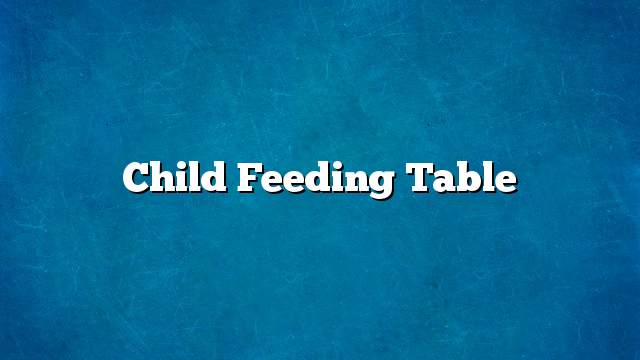Child Feeding
The baby begins to eat after the fourth or sixth month, when the mother starts her child with a slow weaning, in order to prepare the baby for weaning after two years. The food becomes a dietary supplement to the mother’s milk or formula milk, but gradually the mother’s milk becomes the dietary supplement. Many mothers are concerned about the quality of food and the quantity appropriate for each age of the child. In this article, we will introduce you to the child nutrition schedule.
Child Feeding Table
From four to six months
- Food type: Preparation of milk with rice or toast with milk Milk is mother’s milk or artificial milk. Milk can be cooked with unsweetened biscuits, vegetables such as carrots and potatoes, as well as mashed fruits such as apples and fries
- Amount of food: At this stage, the child should be breastfed three to five times a day, as well as two servings of three tablespoons each.
From six to eight months
- Food type: Diversification of meals between vegetables such as potatoes, squash, peas, fruits such as apples, bananas, kohl, apricots, must be mashed, and a little boiled pasta without sauce, as well as boiled rice
- Amount of food: Feed the baby three to five times of natural or artificial milk, plus four meals each meal five teaspoons.
From eight to twelve months
- Food type: Fruits and vegetables, as well as foods rich in protein, such as eggs, and meat, whether red or white, so that one must be provided one day every day; it should be noted that the yolk must be provided without whiteness in eggs.
- Amount of food: Breastfeeding or industry three times a day, as well as five to six servings per day, each consisting of five teaspoons.
Omar years
- Food type: Provide low-fat cow milk, in addition to boiling butter and yogurt; but in small quantities
- Amount of food: Breast feeding or artificial feeding three times or less, in addition to meals at a rate of five to six meals, so that each meal consists of seven teaspoons.
Age two years and above
- Food type: Provide all nutrients, and feed the child from the meals prepared by the mother to the family; so that the meals contain the elements of the integrated diet; the meal must consist of bread and rice, fruits, vegetables, meat and milk.
- Amount of food: Minimize lactation so that the child can eat regular meals, where it can be breastfeeding at bedtime only, in addition to three meals with the family and three other snacks containing fruits, and fruit and nuts, and nuts.
General tips for baby feeding
- Avoid replacing breastmilk or milk with food before the age of the year, as this may lead to many health risks because the child under the year gets 80% of his food needs through breast milk.
- Provide one type of food and continue for three days, and monitor the impact of food on the child, and if some symptoms of allergies to the child should be delayed this type of food to a later.
- Avoid adding salt and sugar to baby food.
- Avoid giving your child before the age of the year green vegetables such as spinach, as well as honey, green peppers, strawberries, berries, cabbage, broccoli, tomatoes, and pineapples.
- Avoid introducing desserts, ice cream, biscuits, and crackers to baby food before the age of the year.
